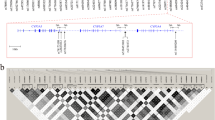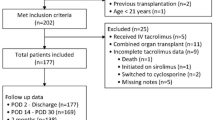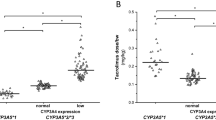Abstract
Aim:
To examine how the endogenous CYP3A4 phenotype and CYP3A5*3 genotype of Chinese renal transplant recipients influenced the dose-corrected trough concentration (C0/D) and weight-corrected daily dose (D/W) of tacrolimus.
Methods:
A total of 101 medically stable kidney transplant recipients were enrolled, and their blood and urine samples were gathered. The endogenous CYP3A4 phenotype was assessed by the ratio of 6β-hydroxycortisol and 6β-hydroxycortisone to cortisol and cortisone in urine. CYP3A5*3 genotype was determined using PCR-RELP.
Results:
In overall renal transplant recipients, a multiple regression analysis including the endogenous CYP3A4 phenotype, CYP3A5*3 genotype and post-operative period accounted for 60.1% of the variability in C0/D ratio; a regression equation consisting of the endogenous CYP3A4 phenotype, post-operative period, body mass index, CYP3A5*3 genotype, gender, total bilirubin and age explained 61.0% of the variability in D/W ratio. In CYP3A5*3/*3 subjects, a combination of the endogenous CYP3A4 phenotype, post-operative period and age was responsible for 65.3% of the variability in C0/D ratio; a predictive equation including the endogenous CYP3A4 phenotype, post-operative period, body mass index, gender and age explained 61.2% of the variability in the D/W ratio. Base on desired target range of tacrolimus trough concentrations, individual daily dosage regimen was calculated, and all the observed daily doses were within the predicted range.
Conclusion:
This study provides the equations to predict tacrolimus metabolism and dosage requirements based on the endogenous CYP3A4 phenotype, CYP3A5*3 genotype and other non-genetic variables.
Similar content being viewed by others
Log in or create a free account to read this content
Gain free access to this article, as well as selected content from this journal and more on nature.com
or
References
Masuda S, Inui K . An up-date review on individualized dosage adjustment of calcineurin inhibitors in organ transplant patients. Pharmacol Ther 2006; 112: 184–98.
Hebert MF . Contributions of hepatic and intestinal metabolism and P-glycoprotein to cyclosporine and tacrolimus oral drug delivery. Adv Drug Deliv Rev 1997; 27: 201–14.
Feng Y, Zhang S, Poloyac S, Strom S, Venkataramanan R . Determination of 13-O-demethyl tacrolimus in human liver microsomal incubates using liquid chromatography–mass spectrometric assay (LC–MS). J Chromatogr B Analyt Technol Biomed Life Sci 2005; 821: 31–7.
Oleson L, von Moltke LL, Greenblatt DJ, Court MH . Identification of polymorphisms in the 3′-untranslated region of the human pregnane X receptor (PXR) gene associated with variability in cytochrome P450 3A (CYP3A) metabolism. Xenobiotica 2010; 40: 146–62.
Kuehl P, Zhang J, Lin Y, Lamba J, Assem M, Schuetz J, et al. Sequence diversity in CYP3A promoters and characterization of the genetic basis of polymorphic CYP3A5 expression. Nat Genet 2001; 27: 383–91.
de Jonge H, de Loor H, Verbeke K, Vanrenterghem Y, Kuypers DR . In vivo CYP3A4 activity, CYP3A5 genotype, and hematocrit predict tacrolimus dose requirements and clearance inrenal transplant patients. Clin Pharmacol Ther 2012; 92: 366–75.
Cascorbi I, Gerloff T, Johne A, Meisel C, Hoffmeyer S, Schwab M, et al. Frequency of single nucleotide polymorphisms in the P-glycoprotein drug transporter MDR1 gene in white subjects. Clin Pharmacol Ther 2001; 69: 169–74.
Galteau MM, Shamsa F . Urinary 6β-hydroxycortisol: a validated test for evaluating drug induction or drug inhibition mediated through CYP3A in humans and in animals. Eur J Clin Pharmacol 2003; 59: 713–33.
Peng CC, Templeton I, Thummel KE, Davis C, Kunze KL, Isoherranen N . Evaluation of 6β-hydroxycortisol, 6β-hydroxycortisone and their combination as endogenous probes for inhibition of CYP3A4 in vivo. Clin Pharmacol Ther 2011; 89: 888–95.
Luo X, Li XM, Hu ZY, Cheng ZN . Evaluation of CYP3A activity in humans using three different parameters based on endogenous cortisol metabolism. Acta Pharmacol Sin 2009; 30: 1323–9.
Zheng L, Luo X, Zhu L, Xie W, Liu S, Cheng Z . Simultaneous determination of cortisol, cortisone, 6β-hydroxycortisol and 6β-hydroxycortisone by HPLC. J Chromatogr Sci 2015; 53: 451–5.
Katz DA, Grimm DR, Cassar SC, Gentile MC, Ye X, Rieser MJ, et al. CYP3A5 genotype has a dose-dependent effect on ABT-773 plasma levels. Clin Pharmacol Ther 2004; 75: 516–28.
Renders L, Frisman M, Ufer M, Mosyagin I, Haenisch S, Ott U, et al. CYP3A5 genotype markedly influences the pharmacokinetics of tacrolimus and sirolimus in kidney transplant recipients. Clin Pharmacol Ther 2007; 81: 228–34.
Anglicheau D, Flamant M, Schlageter MH, Martinez F, Cassinat B, Beaune P, et al. Pharmacokinetic interaction between corticosteroids and tacrolimus after renal transplantation. Nephrol Dial Transplant 2003; 18: 2409–14.
Acknowledgements
The research was funded by the National Natural Science Foundation of China (No 81072700/H3110). The project was funded by the China Postdoctoral Science Foundation (No 2014M562140), Research Fund for Young Scholars of Fujian Province Health and Family Planning Commission (No 2014-1-79) and Scientific Research Foundation for Postdoctoral of Central South University (No 31000-160320068). We gratefully thank Wen-zhao XIE and Ya GONG for gathering the biological samples. We also thank Qing LIU for her kind help with the data analysis.
Author information
Authors and Affiliations
Corresponding author
Additional information
Supplementary Table S1 is available at the Acta Pharmacologica Sinica's website.
Supplementary information
Supplementary Information Table S1
The C0/D and D/W ratios of Tac across the three CYP3A5*3 genotypes in Chinese renal transplant recipients. (DOC 30 kb)
PowerPoint slides
Rights and permissions
About this article
Cite this article
Luo, X., Zhu, Lj., Cai, Nf. et al. Prediction of tacrolimus metabolism and dosage requirements based on CYP3A4 phenotype and CYP3A5*3 genotype in Chinese renal transplant recipients. Acta Pharmacol Sin 37, 555–560 (2016). https://doi.org/10.1038/aps.2015.163
Received:
Accepted:
Published:
Issue date:
DOI: https://doi.org/10.1038/aps.2015.163
Keywords
This article is cited by
-
Composite CYP3A (CYP3A4 and CYP3A5) phenotypes and influence on tacrolimus dose adjusted concentrations in adult heart transplant recipients
The Pharmacogenomics Journal (2024)
-
Effect of CYP3 A4, CYP3 A5 and ABCB1 gene polymorphisms on the clinical efficacy of tacrolimus in the treatment of nephrotic syndrome
BMC Pharmacology and Toxicology (2018)



